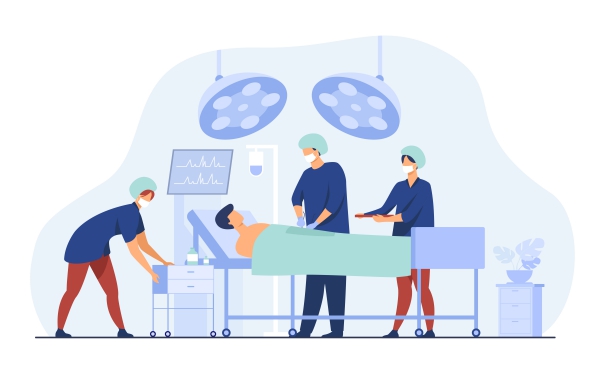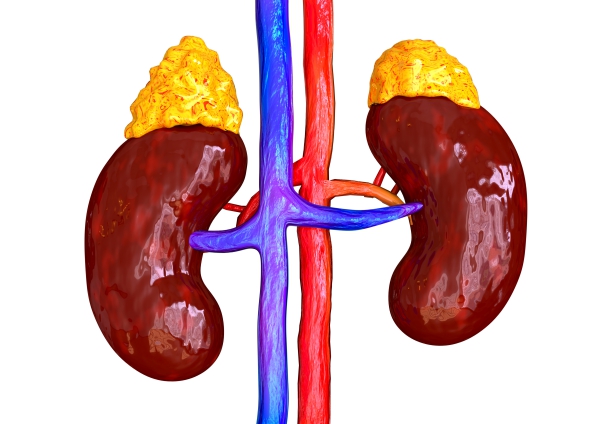What is Conn’s syndrome?
Conn’s syndrome is also known as primary hyperaldosteronism. This condition occurs when your adrenal glands produce too much of the hormone aldosterone. There are two adrenal glands in the body, one sitting on top of each kidney. The adrenal glands produces several hormones, one of them being aldosterone. Aldosterone is a steroid hormone that acts on the kidneys for water and salt (sodium) retention. Therefore an excessive amount of aldosterone will cause your kidneys to retain too much water and salt resulting in excessive fluids within your bloodstream. This excessive fluid can lead to hypertension. In addition, when your kidneys retain salt and water, potassium is lost at the same time in urine.
In the United States, it is estimated that 5-15% of hypertension may be due to primary hyperaldosteronism. It is more common in people who have a low potassium level, in people who are elderly and people who have hypertension which is resistant to medications. In addition, it is more common in African American people. This condition may be due to aldosterone-producing adenomas which are tumours located in the adrenal glands which produce excessive aldosterone. Aldosterone-producing adenomas are more common in women than men with a female-to-male ratio of 2:1.
This condition results in hypokalaemia- decreased level of potassium in the blood- and hypertension which may be life-threatening in severe form.

What causes Conn’s syndrome?
Conn’s syndrome is caused when your adrenal glands produces too much of the hormone aldosterone. This excessive production of aldosterone may be due to:
- Aldosterone-producing adenomas (APAs): APAs are noncancerous (benign) tumours that develops in your adrenal glands which causes excessive production of aldosterone.
- Idiopathic adrenal hyperplasia (IAH): IAH is when the adrenal gland tissue enlarges which results in excessive aldosterone production. This condition may affect one or both adrenal glands. However, it most commonly affects both adrenal glands.
- Genetic-familial primary aldosteronism: This condition is a form of primary aldosteronism that is genetically inherited.
What are the signs and symptoms of Conn’s syndrome?
The signs and symptoms of Conn’s syndrome include:
- Hypertension: Hypertension resistant to medications is often the first clue that may point towards primary hyperaldosteronism.
- Hypokalemia: Hypokalemia in addition to hypertension is very often associated with primary hyperaldosteronism. The low potassium level occurs as a result of aldosterone causing retention of sodium and water by the kidneys at the expense of potassium excretion.
Excessive thirst and frequent passage of large volumes of urine may occur due to hypokalemia-induced nephrogenic diabetes insipidus- which means that due to the low potassium level, your kidneys are unable to concentrate your urine. In addition, hypokalemia causes symptoms like:

- Fatigue
- Muscle weakness
- Headaches
- Cramping
- Palpitations
Primary hyperaldosteronism is to be considered in anyone having hypertension in addition to hypokalemia. Furthermore, it is of utmost importance to make the correct diagnosis to achieve adequate blood pressure control. There are certain diseases or conditions which should be ruled out as they mimic primary hyperaldosteronism and these include:
- Hypertension
- Hypokalemia
- Metabolic alkalosis
- Renal artery stenosis
- Tobacco chewing
- Preeclampsia
- Eclampsia
- Adrenal carcinoma
- Adrenal incidentaloma
- Adrenal surgery
- Barter syndrome
- Iatrogenic Cushing syndrome

Making a diagnosis
To make a diagnosis, your doctor will first take a detailed history from you to know more about your symptoms. After the history taking, your doctor will perform a thorough physical examination to look for signs of primary hyperaldosteronism. In order to confirm the diagnosis, your doctor will order some tests and these include:
- Serum potassium levels: This test is carried out to measure to level of potassium in your blood.
- Serum bicarbonate level: As metabolic alkalosis is associated with primary hyperaldosteronism- meaning the pH of your blood becomes alkaline- the level of bicarbonate is measured. The level of bicarbonate is elevated in metabolic alkalosis.
- Sodium and magnesium levels: In primary hyperaldosteronism, the level of sodium is usually elevated and the level of magnesium is decreased.
- Aldosterone and renin levels: in primary hyperaldosteronism, the level of aldosterone is elevated and the level of renin is decreased. Renin is an enzyme secreted by the kidneys that plays an important role in the regulation of blood pressure. These 2 tests virtually confirms the diagnosis of primary hyperaldosteronism.
- 24-hour urinary aldosterone excretion test: This test is one of the most useful test to confirm the diagnosis of primary hyperaldosteronism as it indicates the total amount of daily aldosterone secretion.
- Salt-loading test: This test involves you ingesting at least 10-12g of salt daily for 5 days prior to the test after which the aldosterone level is measured. In a normal person, the aldosterone level will be decreased. However, in primary hyperaldosteronism, the level of aldosterone will still be elevated.
- Computed Tomography scan: CT scan of the abdomen with contrast is used to detect the presence of tumour within the adrenal glands.
- Magnetic Resonance Imaging (MRI) scan: MRI scan is not superior to CT scan but is especially useful in cases where the use of ionising radiation is prohibited such as during pregnancy.
- Adrenal venous sampling: This test is especially useful when there is no abnormality on imaging tests but blood tests suggest otherwise. This procedure involves your radiologist to draw blood from both your right and left adrenal veins to measure the level of aldosterone in each sample separately. If the level of aldosterone is elevated in one of them, this indicates that there might be a tumour in that respective adrenal gland.


What are the treatments of Conn’s syndrome?
The treatment of Conn’s syndrome include:
- Calcium channel blockers (CCBs): CCBs work by reducing the production of aldosterone.
- Mineralocorticoid antagonists: These drugs work by normalizing your blood volume and potassium level. They are also known as potassium sparring diuretics and an example is spironolactone.
- Glucocorticoids: This class of drug can be used to achieve adequate blood pressure control and examples include prednisolone and hydrocortisone.
- Angiotensin Converting Enzyme (ACE) inhibitors and Angiotensin Receptor Blockers (ARBs): These drugs can also be used to control your blood pressure.
- Adrenal surgery: Surgery is the treatment of choice to treat primary hyperaldosteronism. This surgical procedure is also known as adrenalectomy and can be performed via formal laparotomy or using the laparoscopic technique. The formal laparotomy procedure involves your surgeon making a large incision on your abdomen to reach your adrenal glands. The laparoscopic technique involves your doctor making a few small incisions on your abdomen in order to pass a long tube containing a camera at its end and other tools. Nowadays, the laparoscopic adrenalectomy is preferred.
- Diet: A low salt diet is advised as it is helpful in normalising your blood pressure.
What are the complications of Conn’s syndrome?

Complications of Conn’s syndrome usually result either from chronic high blood pressure or from hypokalemia.
Complications due to chronic hypertension include:
- Myocardial infarction (heart attack)
- Cerebrovascular disease (stroke)
- Congestive heart failure
- Kidney disease or failure
Complications due to hypokalemia include:
- Fatigue
- Abnormal or irregular heart rhythm
- Cramping
- Excessive thirst
- Frequent urination of large volumes of urine
Prognosis
Conn’s syndrome can be life threatening if left untreated as it is accompanied by serious complications. However, about 60-70% of people undergoing surgery will regain a normal blood pressure. It is important to note that your blood pressure will not return to normal immediately after surgery but after 3-6 months. Around 53% of people who have undergone adrenalectomy retain a normal blood pressure even after 5 years. Unfortunately, people affected by primary aldosteronism even without elevated blood pressure may suffer from heart-related complications. Seeking medical advice early and following your treatment plan seriously will significantly improve your prognosis.

Source:
J. Alastair, I. and Simon, M., 2016. Davidson's Essentials of Medicine. 2nd ed. London: ELSEVIER.
Parveen, K. and Michael, C., 2017. Kumar & Clarks Clinical Medicine. 9th ed. The Netherlands: ELSEVIER.
Uwaifo, G., 2020. Primary Aldosteronism Treatment & Management.
Uwaifo, G., 2020. Primary Aldosteronism.



